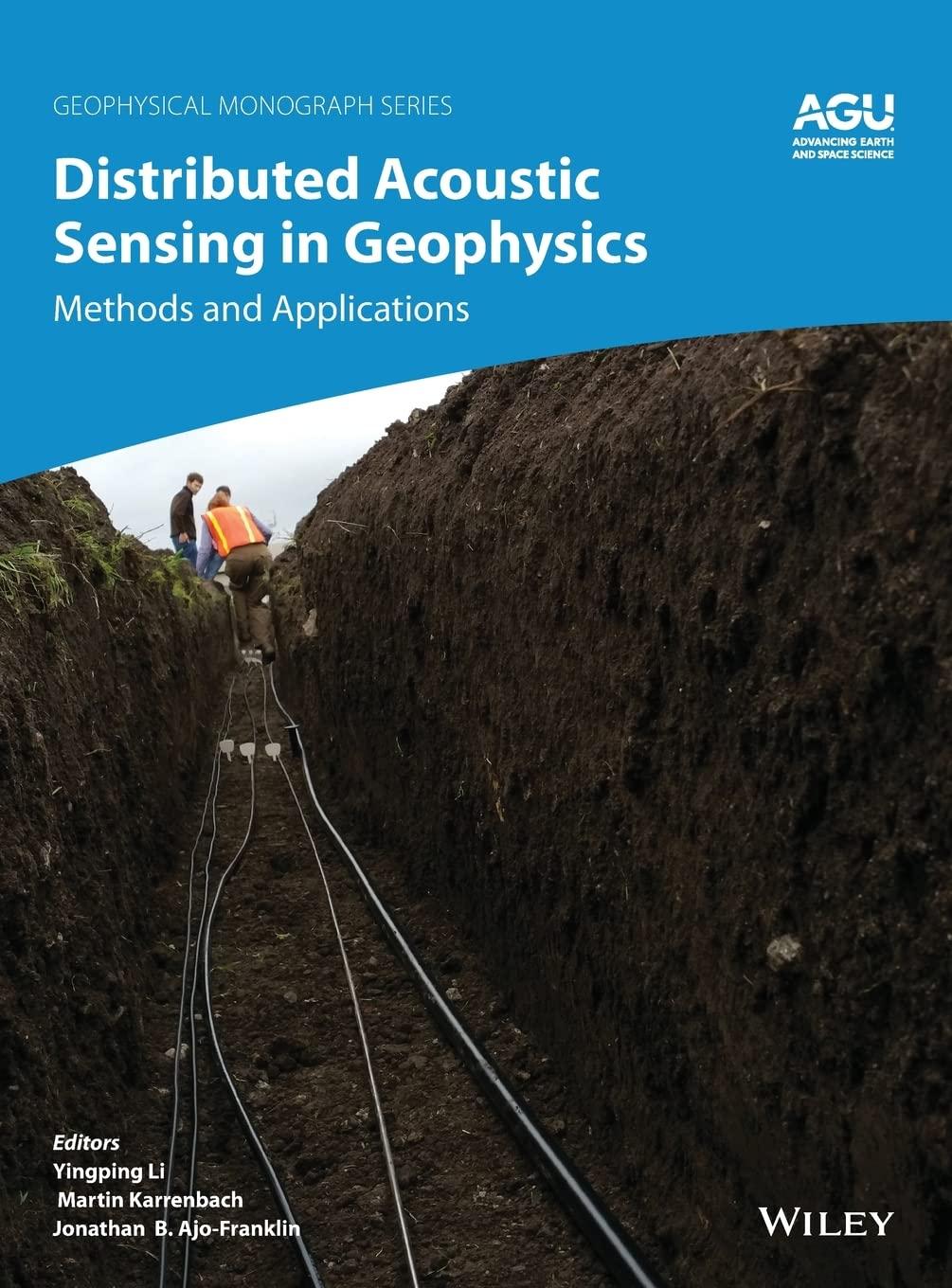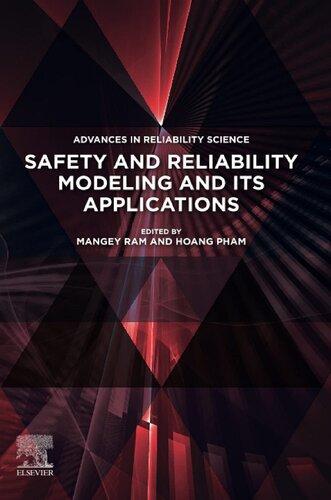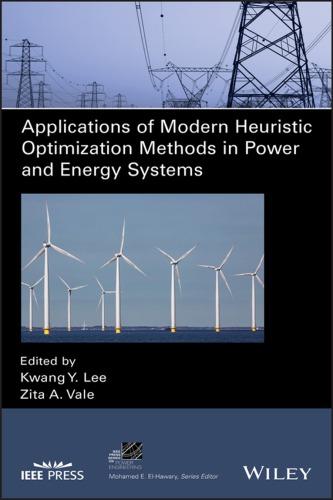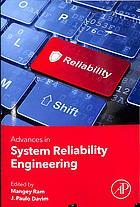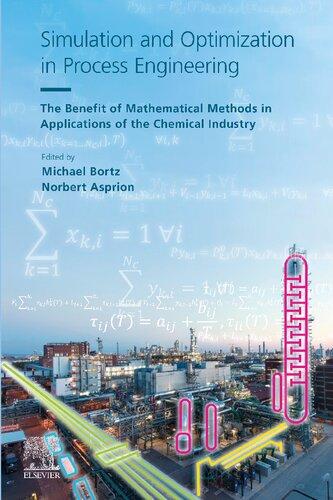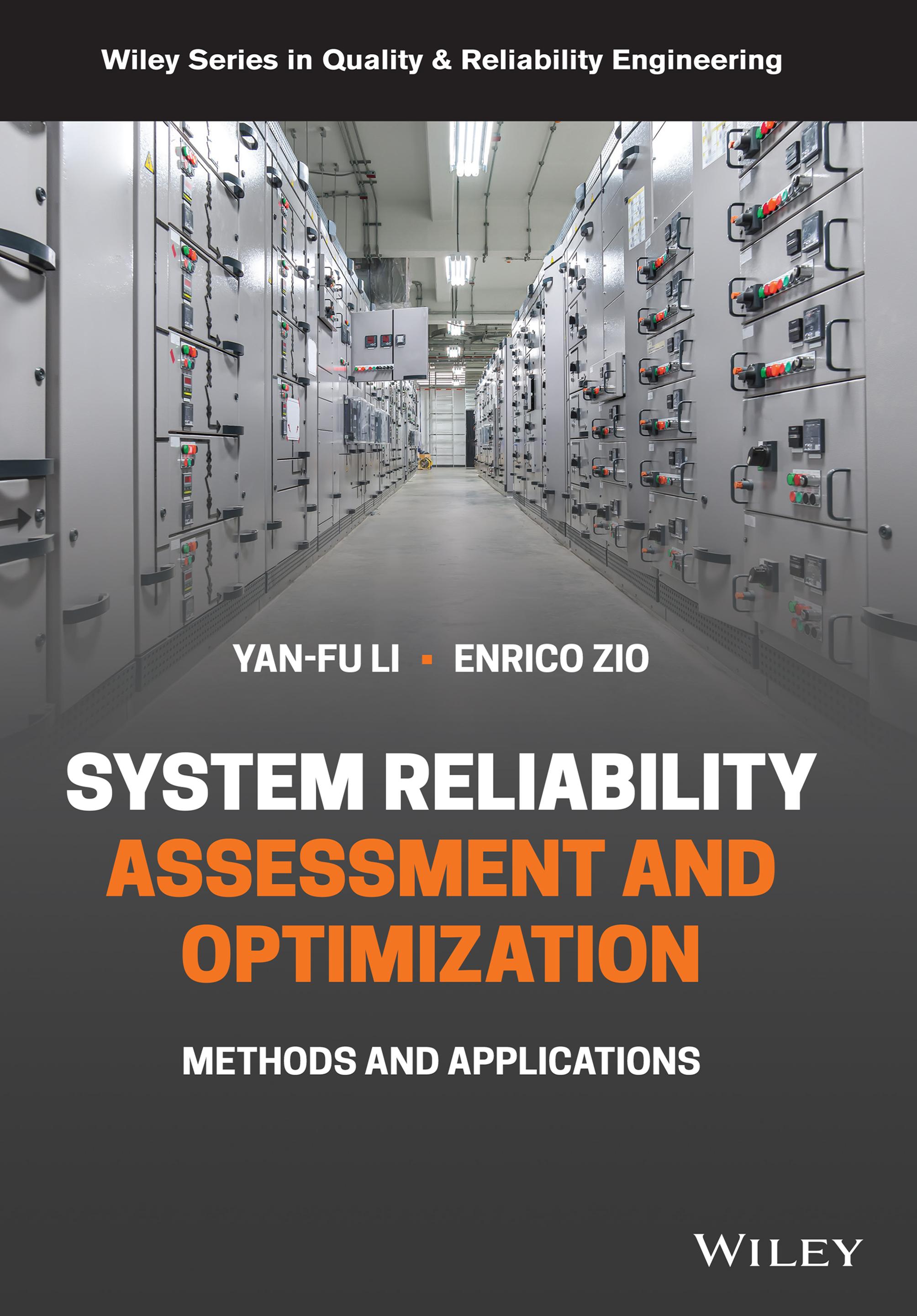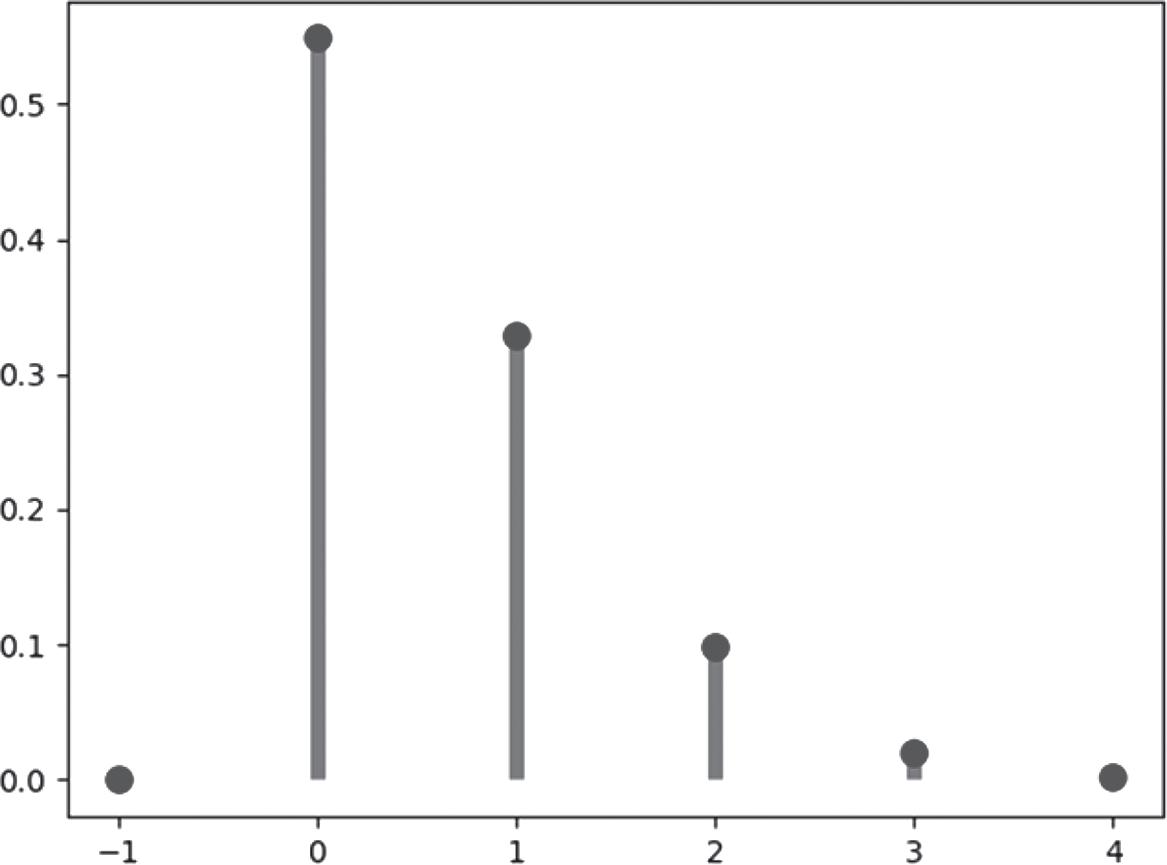Wiley Series in Quality & Reliability Engineering
Dr. Andre V. Kleyner
Series
Editor
The Wiley Series in Quality & Reliability Engineering aims to provide a solid educational foundation for both practitioners and researchers in the Q&R field and to expand the reader’s knowledge base to include the latest developments in this field. The series will provide a lasting and positive contribution to the teaching and practice of engineering. The series coverage will contain, but is not exclusive to,
● Statistical methods
● Physics of failure
● Reliability modeling
● Functional safety
● Six-sigma methods
● Lead-free electronics
● Warranty analysis/management
● Risk and safety analysis
Wiley Series in Quality & Reliability Engineering
System Reliability Assessment and Optimization: Methods and Applications by Yan-Fu Li, Enrico Zio
July 2022
Design for Excellence in Electronics Manufacturing
Cheryl Tulkoff, Greg Caswell
April 2021
Design for Maintainability by Louis J. Gullo (Editor), Jack Dixon (Editor)
March 2021
Reliability Culture: How Leaders can Create Organizations that Create Reliable Products by Adam P. Bahret
February 2021
Lead-free Soldering Process Development and Reliability by Jasbir Bath (Editor) August 2020
Automotive System Safety: Critical Considerations for Engineering and Effective Management
Joseph D. Miller
February 2020
Prognostics and Health Management: A Practical Approach to Improving System
Reliability Using Condition-Based Data by Douglas Goodman, James P. Hofmeister, Ferenc Szidarovszky
April 2019
Improving Product Reliability and Software Quality: Strategies, Tools, Process and Implementation, 2nd Edition
Mark A. Levin, Ted T. Kalal, Jonathan Rodin
April 2019
Practical Applications of Bayesian Reliability
Yan Liu, Athula I. Abeyratne
April 2019
Dynamic System Reliability: Modeling and Analysis of Dynamic and Dependent Behaviors
Liudong Xing, Gregory Levitin, Chaonan Wang
March 2019
Reliability Engineering and Services
Tongdan Jin
March 2019
Design for Safety by Louis J. Gullo, Jack Dixon February 2018
Thermodynamic Degradation Science: Physics of Failure, Accelerated Testing, Fatigue and Reliability by Alec Feinberg October 2016
Next Generation HALT and HASS: Robust Design of Electronics and Systems by Kirk A. Gray, John J. Paschkewitz May 2016
Reliability and Risk Models: Setting Reliability Requirements, 2nd Edition by Michael Todinov November 2015
System Reliability Assessment and Optimization
Methods
and Applications
Yan-Fu Li
Department of Industrial Engineering, Tsinghua University, China
Enrico Zio
MINES ParisTech/PSL Université, Italy
This edition first published 2022
©2022 John Wiley & Sons Ltd
All rights reserved. No part of this publication may be reproduced, stored in a retrieval system, or transmitted, in any form or by any means, electronic, mechanical, photocopying, recording or otherwise, except as permitted by law. Advice on how to obtain permission to reuse material from this title is available at http://www.wiley.com/go/permissions.
The right of Yan-Fu Li and Enrico Zio to be identified as the authors of this work has been asserted in accordance with law.
Registered Offices
John Wiley & Sons, Inc., 111 River Street, Hoboken, NJ 07030, USA
John Wiley & Sons Ltd, The Atrium, Southern Gate, Chichester, West Sussex, PO19 8SQ, UK
Editorial Office
The Atrium, Southern Gate, Chichester, West Sussex, PO19 8SQ, UK
For details of our global editorial offices, customer services, and more information about Wiley products visit us at www.wiley.com.
Wiley also publishes its books in a variety of electronic formats and by print-on-demand. Some content that appears in standard print versions of this book may not be available in other formats.
Limit of Liability/Disclaimer of Warranty
While the publisher and authors have used their best efforts in preparing this work, they make no representations or warranties with respect to the accuracy or completeness of the contents of this work and specifically disclaim all warranties, including without limitation any implied warranties of merchantability or fitness for a particular purpose. No warranty may be created or extended by sales representatives, written sales materials or promotional statements for this work. The fact that an organization, website, or product is referred to in this work as a citation and/or potential source of further information does not mean that the publisher and authors endorse the information or services the organization, website, or product may provide or recommendations it may make. This work is sold with the understanding that the publisher is not engaged in rendering professional services. The advice and strategies contained herein may not be suitable for your situation. You should consult with a specialist where appropriate. Further, readers should be aware that websites listed in this work may have changed or disappeared between when this work was written and when it is read. Neither the publisher nor authors shall be liable for any loss of profit or any other commercial damages, including but not limited to special, incidental, consequential, or other damages.
Library of Congress Cataloging-in-Publication Data
Names: Li, Yan-Fu, author. | Zio, Enrico, author.
Title: System reliability assessment and optimization: methods and applications / Yan-Fu Li, Enrico Zio.
Description: Hoboken, NJ : John Wiley & Sons, 2022. | Series: Wiley series in quality & reliability engineering | Includes bibliographical references and index.
Identifiers: LCCN 2022009590 (print) | LCCN 2022009591 (ebook) | ISBN 9781119265870 (hardback) | ISBN 9781119265924 (pdf) | ISBN 9781119265863 (epub) | ISBN 9781119265856 (ebook)
Subjects: LCSH: Reliability (Engineering) | Industrial safety.
Classification: LCC TA169 .Z57 2022 (print) | LCC TA169 (ebook) | DDC 620/.00452--dc23/eng/20220316
LC record available at https://lccn.loc.gov/2022009590
LC ebook record available at https://lccn.loc.gov/2022009591
Cover image: © Vithun Khamsong/Getty Images
Cover design by Wiley
Set in 9.5/12.5pt STIXTwoText by Integra Software Services Pvt. Ltd, Pondicherry, India
To all the students, collaborators and colleagues, to whom we are forever indebted for all the enriching experience and knowledge that they have shared with us and that have made us grow professionally and personally.
Contents
Series Editor’s Foreword by Dr. Andre V. Kleyner xv
Preface xvii
Acknowledgments xix
List of Abbreviations xx
Notations xxii
Part I The Fundamentals 1
1 Reliability Assessment 3
1.1 Definitions of Reliability 3
1.1.1 Probability of Survival 3
1.2 Component Reliability Modeling 6
1.2.1 Discrete Probability Distributions 6
1.2.2 Continuous Probability Distributions 8
1.2.3 Physics-of-Failure Equations 13
1.3 System Reliability Modeling 15
1.3.1 Series System 15
1.3.2 Parallel System 16
1.3.3 Series-parallel System 16
1.3.4 K-out-of-n System 17
1.3.5 Network System 18
1.4 System Reliability Assessment Methods 18
1.4.1 Path-set and Cut-set Method 18
1.4.2 Decomposition and Factorization 19
1.4.3 Binary Decision Diagram 19
1.5 Exercises 20
References 22
2 Optimization 23
2.1 Optimization Problems 23
2.1.1 Component Reliability Enhancement 23
2.1.2 Redundancy Allocation 24
2.1.3 Component Assignment 25
2.1.4 Maintenance and Testing 26
2.2 Optimization Methods 30
2.2.1 Mathematical Programming 30
2.2.2 Meta-heuristics 34
2.3 Exercises 36
References 37
Part II Reliability Techniques 41
3 Multi-State Systems (MSSs) 43
3.1 Classical Multi-state Models 43
3.2 Generalized Multi-state Models 45
3.3 Time-dependent Multi-State Models 46
3.4 Methods to Evaluate Multi-state System Reliability 48
3.4.1 Methods Based on MPVs or MCVs 48
3.4.2 Methods Derived from Binary State Reliability Assessment 48
3.4.3 Universal Generating Function Approach 49
3.4.4 Monte Carlo Simulation 50
3.5 Exercises 51
References 51
4 Markov Processes 55
4.1 Continuous Time Markov Chain (CMTC) 55
4.2 In homogeneous Continuous Time Markov Chain 61
4.3 Semi-Markov Process (SMP) 66
4.4 Piecewise Deterministic Markov Process (PDMP) 74
4.5 Exercises 82
References 84
5 Monte Carlo Simulation (MCS) for Reliability and Availability Assessment 87
5.1 Introduction 87
5.2 Random Variable Generation 87
5.2.1 Random Number Generation 87
5.2.2 Random Variable Generation 89
5.3 Random Process Generation 93
5.3.1 Markov Chains 93
5.3.2 Markov Jump Processes 94
5.4 Markov Chain Monte Carlo (MCMC) 97
5.4.1 Metropolis-Hastings (M-H) Algorithm 97
5.4.2 Gibbs Sampler 98
5.4.3 Multiple-try Metropolis-Hastings (M-H) Method 99
5.5 Rare-Event Simulation 101
5.5.1 Importance Sampling 101
5.5.2 Repetitive Simulation Trials after Reaching Thresholds (RESTART) 102
5.6 Exercises 103
Appendix 104
References 115
6 Uncertainty Treatment under Imprecise or Incomplete Knowledge 117
6.1 Interval Number and Interval of Confidence 117
6.1.1 Definition and Basic Arithmetic Operations 117
6.1.2 Algebraic Properties 118
6.1.3 Order Relations 119
6.1.4 Interval Functions 120
6.1.5 Interval of Confidence 121
6.2 Fuzzy Number 121
6.3 Possibility Theory 123
6.3.1 Possibility Propagation 124
6.4 Evidence Theory 125
6.4.1 Data Fusion 128
6.5 Random-fuzzy Numbers (RFNs) 128
6.5.1 Universal Generating Function (UGF) Representation of Random-fuzzy Numbers 129
6.5.2 Hybrid UGF (HUGF) Composition Operator 130
6.6 Exercises 132
References 133
7 Applications 135
7.1 Distributed Power Generation System Reliability Assessment 135
7.1.1 Reliability of Power Distributed Generation (DG) System 135
7.1.2 Energy Source Models and Uncertainties 136
7.1.3 Algorithm for the Joint Propagation of Probabilistic and Possibilistic Uncertainties 138
7.1.4 Case Study 140
7.2 Nuclear Power Plant Components Degradation 140
7.2.1 Dissimilar Metal Weld Degradation 140
7.2.2 MCS Method 145
7.2.3 Numerical Results 147
References 149
Part III Optimization Methods and Applications 151
8 Mathematical Programming 153
8.1 Linear Programming (LP) 153
8.1.1 Standard Form and Duality 155
8.2 Integer Programming (IP) 159
8.3 Exercises 164
References 165
9 Evolutionary Algorithms (EAs) 167
9.1 Evolutionary Search 168
9.2 Genetic Algorithm (GA) 170
9.2.1 Encoding and Initialization 171
9.2.2 Evaluation 172
9.2.3 Selection 173
9.2.4 Mutation 174
9.2.5 Crossover 175
9.2.6 Elitism 178
9.2.7 Termination Condition and Convergence 178
9.3 Other Popular EAs 179
9.4 Exercises 181
References 182
10 Multi-Objective Optimization (MOO) 185
10.1 Multi-objective Problem Formulation 185
10.2 MOO-to-SOO Problem Conversion Methods 187
10.2.1 Weighted-sum Approach 188
10.2.2 ε-constraint Approach 189
10.3 Multi-objective Evolutionary Algorithms 190
10.3.1 Fast Non-dominated Sorting Genetic Algorithm (NSGA-II) 190
10.3.2 Improved Strength Pareto Evolutionary Algorithm (SPEA 2) 193
10.4 Performance Measures 197
10.5 Selection of Preferred Solutions 200
10.5.1 “Min-Max” Method 200
10.5.2 Compromise Programming Approach 201
10.6 Guidelines for Solving RAMS+C Optimization Problems 201
10.7 Exercises 203
References 204
11 Optimization under Uncertainty 207
11.1 Stochastic Programming (SP) 207
11.1.1 Two-stage Stochastic Linear Programs with Fixed Recourse 209
11.1.2 Multi-stage Stochastic Programs with Recourse 217
11.2 Chance-Constrained Programming 218
11.2.1 Model and Properties 219
11.2.2 Example 221
11.3 Robust Optimization (RO) 222
11.3.1 Uncertain Linear Optimization (LO) and its Robust Counterparts 223
11.3.2 Tractability of Robust Counterparts 224
11.3.3 Robust Optimization (RO) with Cardinality Constrained Uncertainty Set 225
11.3.4 Example 226
11.4 Exercises 228
References 229
12 Applications 231
12.1 Multi-objective Optimization (MOO) Framework for the Integration of Distributed Renewable Generation and Storage 231
12.1.1 Description of Distributed Generation (DG) System 232
12.1.2 Optimal Power Flow (OPF) 234
12.1.3 Performance Indicators 235
12.1.4 MOO Problem Formulation 237
12.1.5 Solution Approach and Case Study Results 238
12.2 Redundancy Allocation for Binary-State Series-Parallel Systems (BSSPSs) under Epistemic Uncertainty 240
12.2.1 Problem Description 240
12.2.2 Robust Model 241
12.2.3 Experiment 243
References 244
Index 245
Series Editor’s Foreword
Dr. Andre V. Kleyner
The Wiley Series in Quality & Reliability Engineering aims to provide a solid educational foundation for researchers and practitioners in the field of quality and reliability engineering and to expand the knowledge base by including the latest developments in these disciplines.
The importance of quality and reliability to a system can hardly be disputed. Product failures in the field inevitably lead to losses in the form of repair cost, warranty claims, customer dissatisfaction, product recalls, loss of sale, and in extreme cases, loss of life.
Engineering systems are becoming increasingly complex with added functions and capabilities; however, the reliability requirements remain the same or even growing more stringent. Modeling and simulation methods, such as Monte Carlo simulation, uncertainty analysis, system optimization, Markov analysis and others, have always been important instruments in the toolbox of design, reliability and quality engineers. However, the growing complexity of the engineering systems, with the increasing integration of hardware and software, is making these tools indispensable in today’s product development process.
The recent acceleration of the development of new technologies including digitalization, forces the reliability professionals to look for more efficient ways to deliver the products to market quicker while meeting or exceeding the customer expectations of high product reliability. It is important to comprehensively measure the ability of a product to survive in the field. Therefore, modeling and simulation is vital to the assessment of product reliability, including the effect of variance on the expected product life, even before the hardware is built. Variance is present in the design parameters, material properties, use conditions, system interconnects, manufacturing conditions, lot-to-lot variation and many other product inputs, making it difficult to assess. Thus, modeling and simulation may be the only tools to fully evaluate the effect of variance in the early product development phases and to eventually optimize the design.
The book you are about to read has been written by leading experts in the field of reliability modeling, analysis, simulation and optimization. The book covers important topics, such as system reliability assessment, modeling and simulation, multi-state systems, optimization methods and their applications, which are highly critical to meeting the high demands for quality and reliability. Achieving the optimal feasible performance of
the system is eventually the final objective in modern product design and manufacturing, and this book rightfully puts a lot of emphasis on the process of optimization.
Paradoxically, despite its evident importance, quality and reliability disciplines are somewhat lacking in today’s engineering educational curricula. Only few engineering schools offer degree programs, or even a sufficient set of courses, in quality and reliability methods. The topics of reliability analysis, accelerated testing, reliability modeling and simulation, warranty data analysis, reliability growth programs, reliability design optimization and other aspects of reliability engineering receive very little coverage in today’s engineering students curricula. As a result, the majority of the quality and reliability practitioners receive their professional training from colleagues, professional seminars and professional publications. In this respect, this book is intended to contribute to closing this gap and provide additional educational material as a learning opportunity for a wide range of readers from graduate level students to seasoned reliability professionals.
We are confident that this book, as well as this entire book series, will continue Wiley’s tradition of excellence in technical publishing and provide a lasting and positive contribution to the teaching and practice of reliability and quality engineering.
Preface
Engineering systems, like process and energy systems, transportation systems, structures like bridges, pipelines, etc., are designed to ensure successful operation throughout the anticipated service lifetime in compliance with given all-around sustainability requirements. This calls for design, operation, and maintenance solutions to achieve the sustainability targets with maximum benefit from system operation. Reliability, availability, maintainability and Safety criteria (RAMS) are among the indicators for measuring system functionality with respect to these intended targets.
Today, modern engineering systems are becoming increasingly complex to meet the high expectations by the public for high functionality, performance, and reliability, and with this, RAMS properties have become further key issues in design, maintenance, and successful commercialization.
With high levels of RAMS being demanded on increasingly complex systems, the reliability assessment and optimization methods and techniques need to be continuously improved and advanced. As a result, many efforts are being made to address various challenges in complex engineering system lifecycle management under the global trend of systems integration. Mathematically and computationally, the reliability assessment and optimization are challenged by various issues related to the uncertain, dynamic, multi-state, non-linear interdependent characteristics of the modern engineering systems and the problem of finding optimal solutions in irregular search spaces characterized by non-linearity, non-convexity, time-dependence and uncertainty.
In the evolving and challenging RAMS engineering context depicted above, this book provides a precise technical view on system reliability methods and their application to engineering systems. The methods are described in detail with respect to their mathematical formulation and their application is illustrated through numerical examples and is discussed with respect to advantages and limitations. Applications to real world cases are given as a contribution to bridging the gap between theory and practice.
The book can serve as a solid theoretical and practical basis for solving reliability assessment and optimization problems regarding systems of different engineering disciplines and for further developing and advancing the methods to address the newly arising challenges as technology evolves.
Reliability engineering is founded on scientific principles and deployed by mathematical tools for analyzing components and systems to guarantee they provide their functions as intended by design.
On the other hand, technological advances continuously bring changes of perspectives, in response to the needs, interests, and priorities of the practical engineering world. As technology advances at a fast pace, the complexity of modern engineered systems increases and so do, at the same time, the requirements for performance, efficiency, and reliability. This brings new challenges that demand continuous developments and advancements in complex system reliability assessment and optimization.
Therefore, system reliability assessment and optimization is inevitably a living field, with solution methodologies continuously evolving through the advancements of mathematics and simulation to follow up the development of new engineering technology and the changes in management perspectives. For this, advancements in the fields of operations research, reliability, and optimization theory and computation continuously improve the methods and techniques for system reliability assessment and optimization and for their application to very large and increasingly complex systems made of a large number of heterogeneous components with many interdependencies under various physical and economic constraints.
Within the ongoing efforts of development and advancement, this book presents an overview of methods for assessing and optimizing system reliability. We address different types of system reliability assessment and optimization problems and the different approaches for their solutions. We consider the development and advancement in the fields of operations research, reliability, and optimization theory to tackle the reliability assessment and optimization of complex systems in different technological domains.
The book is directed to graduate students, researchers and practitioners in the areas of system reliability, availability, maintainability and Safety (RAMS), and it is intended to provide an overview of the state of knowledge of and tools for reliability assessment and system optimization. It is organized in three parts to introduce fundamentals, and illustrate methods and applications.
The first part reviews the concepts, definitions and metrics of reliability assessment and the formulations of different types of reliability optimization problems depending on the nature of the decision variables and considering redundancy allocation and maintenance and testing policies. Plenty of numerical examples are provided to accompany the understanding of the theoretical concepts and methods.
The second part covers multi-state system (MSS) modeling and reliability evaluation, Markov processes, Monte Carlo simulation (MCS), and uncertainty treatment under poor knowledge. The reviewed methods range from piecewise-deterministic Markov processes (PDMPs) to belief functions.
The third part of the book is devoted to system reliability optimization. In general terms, system reliability optimization involves defining the decision variables, the constraints and the single or multiple objective functions that describe the system reliability performance and involves searching for the combination of values of the decision variables that realize the target values the objective functions. Different formulations and methods are described with precise mathematical details and illustrative numerical examples, covering mathematical programming, evolutionary algorithms, multi-objective optimization (MOO) and optimization under uncertainty, including robust optimization (RO).
Applications of the assessment and optimization methods to real-world cases are also given, concerning for example the reliability of renewable energy systems. From this point of view, the book bridges the gap between theoretical development and engineering practice.
Acknowledgments
Live long and prosper, RAMS and system reliability! The authors would express the deepest appreciations to the great scholars along the line of honors and achievements for their inspirations and role modeling.
Many thanks to the postgraduate students in Tsinghua: Tianli Men, Hanxiao Zhang, Ruochong Liu, Chen Zhang and Chuanzhou Jia. Thanks for their priceless efforts in editing, depicting, and proofreading in various chapters.
The authors would like to specially thank the Wiley colleagues for their continuous and kindhearted monitoring and encouragement throughout the years.
At last, this work is supported in part by the National Natural Science Foundation of China under a key project grant No. 71731008 and the Beijing Natural Science Foundation grant No. L191022.
List of Abbreviations
ABC artificial bee colony algorithm
ACO ant colony optimization
AGAN as-good-as-new
B&B branch-and-bound
BBA basic belief assignment
BDD binary decision diagram
BFS basic feasible solution
BSS binary state system
BSSPS binary-state series-parallel system
cdf cumulative distribution function
CG column generation
CLT Central Limit Theorem
CTMC continuous time Markov chain
CVaR conditional value-at-risk
DC direct current
DE deterministic equivalent
DE differential evolution
DG distributed generation
DM decision maker
DP dynamic programming
DTMC discrete time Markov chain
EA evolutionary algorithm
ENS energy not supplied
EENS expected energy not supplied
EV electrical vehicles
FV finite-volume
GA genetic algorithm
GD generational distance
HCTMC homogeneous CTMC
HPIS high-pressure injection system
HUGF hybrid UGF
HV hyper-volume
ICTMC inhomogeneous CTMC
ILP integer linear programming
IP integer programming
LO Linear optimization
LP linear programming
LPM LP master problem
MCMC Markov Chain Monte Carlo
MCS Monte Carlo simulation
MCS-OPF Monte Carlo simulation – optimal power flow
MCV minimal cut vector
MDD multi-valued decision diagram
MH Metropolis-Hastings
MIP mixed integer programming
MOO multi-objective optimization
MP mathematical programming
MPV minimal path vector
MRC Markov renewal chain
MS Main supply power spot
MSCS multi-state coherent system
MSM multi-state model
MSMS multi-state monotone system
MSS multi-state system
MTBF mean time between failures
MTBR mean time between repairs
MTTF mean time to failure
NLP non-linear programming
NPGA niched Pareto GA
NPP nuclear power plant
NSGA-II fast non-dominated sorting genetic algorithm
OPF optimal power flow
pdf probability density function
PDMP piecewise-deterministic Markov process
pmf probability mass function
P-o-F Physics-of-Failure
PSO particle swarm optimization
PV solar photovoltaic
RAM reliability, availability, and maintainability
RAMS RAM and Safety criteria
RAMS+C RAMS and Cost
RAP redundancy allocation problem
RC robust counterpart
RESTART Repetitive Simulation Trials After Reaching Thresholds
RFN random-fuzzy number
List of Abbreviations xxi
List of Abbreviations xxii
RLPM restricted LPM
RO robust optimization
SMP semi-Markov process
SODE single-object DE
SOEA single-objective EA
SOGA single-objective GA
SOO single-objective optimization
SOPSO single-objective PSO
SP stochastic programming
SPEA strength Pareto evolutionary algorithm
SPEA 2 improved strength Pareto evolutionary algorithm
SSO social spider optimization
ST storage device
TDMSM time-dependent MSM
TIMSM time-independent MSM
TS Tabu search
UGF universal generating function
VEGA vector-evaluated GA
W wind turbine
Notations: Part I
t time point
nt f () number of failed items
nt s () number of the survived items
n0 sample size
T random variable of the failure time
Ft() cdf of failure time
ft() pdf of failure time
Rt() reliability at time t
ht() hazard function at time t
Ht() cumulative hazard function at time t
Qt() estimate of the unreliability
Rt() estimate of the reliability
Dt() component or system demand at time t
Gt() performance function at time t
MTTF mean time to failure
X random variable
List of Abbreviations xxiii
a crack length
N load cycle
Q total volume of wear debris produced
Rt s () reliability of the system at time t
⋅ () unreliability function of the system
C cost
x decision variable
gx() inequality constraints
hx() equality constraints
fx() criterion function
DV A = () , directed graph
d ⋅ () length of the shortest path
Notations: Part II
t time point
S state set
M perfect state
x =…() xx n 1 ,, component state vector
X =…() XX n 1 ,, state of all components
φ () structure function of the system
gi performance level of component i
λkj i transition rate of component i from state k to state j
Qt kj i () kernel of the SMP analogous to λkj i of the CTMC
Tn i time of the n -th transition of component i
Gn i performance of component i at the n -th transition
θ jk i t () probability that the process of component i starts from state j at time t
At W
ϕ () availability with a minimum on performance of total ϕ at time t
uz i () universal generating function of component i
pX j ij i ==() Pr probability of component i being at state j
p t () state probability vector
λij t () transition rate from state i to state j at time t in Markov process
Λ
Λ transition rate matrix
Π⋅() possibility function
N () necessity function
List of Abbreviations
Bel ⋅ () belief function
Pl () plausibility function
F () 1 inverse function
E () expectation equation
⊗ UGF composition operator
Π⋅() possibility function
N ⋅ () necessity function
Bel ⋅ () belief function
Pl () plausibility function
F () 1 inverse function
E () expectation equation
S () system safety function
Risk ⋅ () system risk function
C ⋅ () cost function
Notation: Part III
ri reliability of subsystem i
x =…() xx n T 1 ,, decision variable vector
c cc n T 1 ,, coefficients of the objective function
b bb m T 1 ,, right-hand side values of the inequality constraints
z =…() zz z M 12,, , objective vector
xl lL * , ,, ,=… 12 set of optimal solutions
w =…() ww w M 12,, , weighting vector
x * global optimal solution
R ⋅ () system reliability function
A () system availability function
M () system maintainability function system safety function
C () cost function
Risk ⋅ () system risk function
R N N -dimensional solution space
fi i -th objective functions
g j j -th equality constraints
hk k -th inequality constraints
List of Abbreviations xxv
ω ω random event
ξ ξ = () () () () qh T ωω ω TT T , , second-stage problem parameters
W recourse matrix
y ω () second-stage or corrective actions
Q x () expected recourse function
U uncertainty set
u uncertainty parameters
ζ perturbation vector
Z perturbation set
x u * optimal solution under the uncertainty parameter u
Part I
The Fundamentals
1
Reliability Assessment
Reliability is a critical attribute for the modern technological components and systems. Uncertainty exists on the failure occurrence of a component or system, and proper mathematical methods are developed and applied to quantify such uncertainty. The ultimate goal of reliability engineering is to quantitatively assess the probability of failure of the target component or system [1]. In general, reliability assessment can be carried out by both parametric or nonparametric techniques. This chapter offers a basic introduction to the related definitions, models and computation methods for reliability assessments.
1.1 Definitions of Reliability
According to the standard ISO 8402, reliability is the ability of an item to perform a required function, under given environmental and operational conditions and for a stated period of time without failure. The term “item” refers to either a component or a system. Under different circumstances, the definition of reliability can be interpreted in two different ways:
1.1.1 Probability of Survival
Reliability of an item can be defined as the complement to its probability of failure, which can be estimated statistically on the basis of the number of failed items in a sample. Suppose that the sample size of the item being tested or monitored is n0 . All items in the sample are identical, and subjected to the same environmental and operational conditions. The number of failed items is n f and the number of the survived ones is ns , which satisfies
Reliability Assessment and Optimization: Methods and Applications,
The percentage of the failed items in the tested sample is taken as an estimate of the unreliability, Q , Q
Complementarily, the estimate of the reliability, R , of the item is given by the percentage of survived components in the sample:
Example 1.1
A valve fabrication plant has an average output of 2,000 parts per day. Five hundred valves are tested during a reliability test. The reliability test is held monthly. During the past three years, 3,000 valves have failed during the reliability test. What is the reliability of the valve produced in this plant according to the test conducted?
Solution
The total number of valves tested in the past three years is
n0 500 12 3 18000 =× ×=
The number of failed components is
n f = 3000
According to Equation 1.3, an estimate of the valve reliability is
1.1.2 Probability of Time to Failure
Let random variable T denote the time to failure. Then, the reliability function at time t can be expressed as the probability that the component does not fail at time t , that is,
Denote the cumulative distribution function (cdf) of T as Ft() . The relationship between the cdf and the reliability is
1.1 Definitions of Reliability 5
Further, denote the probability density function (pdf) of failure time T as ft(). Then, equation (1.5) can be rewritten as
Example 1.2
The failure time of a valve follows the exponential distribution with parameter λ = 0 025 (in arbitrary units of time-1). The value is new and functioning at time t = 0 . Calculate the reliability of the valve at time t = 30 (in arbitrary units of time).
Solution
The pdf of the failure time of the valve is
ee t tt () == ≥ λ λ 0 025 0 0 025 ., .
The reliability function of the valve is given by
At time t = 30 , the value of the reliability is
In all generality, the expected value or mean of the time to failure T is called the mean time to failure (MTTF), which is defined as
It is equivalent to
Another related concept is the mean time between failures (MTBF). MTBF is the average working time between two consecutive failures. The difference between MTBF and MTTF is that the former is used only in reference to a repairable item, while the latter is used for non-repairable items. However, MTBF is commonly used for both repairable and non-repairable items in practice.
The failure rate function or hazard rate function, denoted by ht(), is defined as the conditional probability of failure in the time interval tt t , +
∆ given that it has been working properly up to time t , which is given by
Furthermore, the cumulative failure rate function, or cumulative hazard function, denoted by Ht() , is given by
1.2 Component Reliability Modeling
As mentioned in the previous section, in reliability engineering, the time to failure of an item is a random variable. In this section, we briefly introduce several commonly used discrete and continuous distributions for component reliability modeling.
1.2.1 Discrete Probability Distributions
If random variable X can take only a finite number k of different values xx x k 12,, , or an infinite sequence of different values xx12,,…, the random variable X has a discrete probability distribution. The probability mass function (pmf) of X is defined as the function f such that for every real number x ,
If x is not one of the possible values of X , then fx() = 0 . If the sequence xx12,,… includes all the possible values of X , then ∑ () = i i fx 1 . The cdf is given by
1.2.1.1
Binomial Distribution
Consider a machine that produces a defective item with probability pp (01) << and produces a non-defective item with probability 1 p . Assume the events of defects in different items are mutually independent. Suppose the experiment consists of examining a sample of n of these items. Let X denote the number of defective items in the sample. Then, the random variable X follows a binomial distribution with parameters n and p and has the discrete distribution represented by the pmf in (1.14), shown in Figure 1.1. The random variable with this distribution is said to be a binomial random variable, with parameters n and p ,
Figure 1.1 The pmf of the binomial distribution with np==50,.4
fx n x pp forx n otherwise x nx () =
The pmf of the binomial distribution is
For a binomial distribution, the mean, µ , is given by
and the variance, σ 2 , is given by
1.2.1.2 Poisson Distribution
Poisson distribution is widely used in quality and reliability engineering. A random variable X has the Poisson distribution with parameter λλ , , > 0 the pmf (shown in Figure 1.2) of X is as follows:
e x forx otherwise x () =
The mean and variance of the Poisson distribution are
1.2.2 Continuous Probability Distributions
We say that a random variable X has a continuous distribution or that X is a continuous random variable if there exists a nonnegative function f , defined on the real line, such that for every interval of real numbers (bounded or unbounded), the probability that X takes a value in an interval ab ,
is the integral of f over that interval, that is,
If X has a continuous distribution, the function f will be the probability density function (pdf) of X . The pdf must satisfy the following requirements:
The cdf of a continuous distribution is given by
Figure 1.2 The pmf of the Poisson distribution with λ = 06 .

